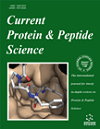- Home
- A-Z Publications
- Current Protein and Peptide Science
- Previous Issues
- Volume 19, Issue 8, 2018
Current Protein and Peptide Science - Volume 19, Issue 8, 2018
Volume 19, Issue 8, 2018
-
-
The Acidophilic Kinases PLK2 and PLK3: Structure, Substrate Targeting and Inhibition
More LessAuthors: Giorgio Cozza and Mauro SalviPLK2 and PLK3 are two closely related acidophilic kinases belonging to the Polo-like kinases (PLKs), a family of five members in mammals with a central role in cell cycle and related events. PLK1 is the most investigated enzyme from both physiological and pharmaceutical points of view, however, several specialized cellular functions of PLK2 and PLK3 have been recently discovered paving the way to deepened studies on Read More
-
-
-
Viscosity Control of Protein Solution by Small Solutes: A Review
More LessAuthors: Taehun Hong, Kazuki Iwashita and Kentaro ShirakiViscosity of protein solution is one of the most troublesome issues for the high-concentration formulation of protein drugs. In this review, we summarize the practical methods that suppress the viscosity of protein solution using small molecular additives. The small amount of salts decreases the viscosity that results from electrostatic repulsion and attraction. The chaotrope suppresses the hydrophobic attraction an Read More
-
-
-
The Potential Use of Peptides in Cancer Treatment
More LessAuthors: Bahram Yavari, Reza Mahjub, Masoud Saidijam, Mozhgan Raigani and Meysam SoleimaniConventional chemotherapeutic drugs have significant limitations. For example, tumors may develop resistance, cancers may relapse after treatment, and the drugs may induce secondary malignancies in the treatment of metastatic cancer. There is still a great need for drugs that are able to destroy cancer cells selectively, that is, to effectively treat slow-growing and dormant cells without being affected by chemoresis Read More
-
-
-
Biosynthesis of Carnosine and Related Dipeptides in Vertebrates
More LessAuthors: Sebastian Kwiatkowski, Anna Kiersztan and Jakub DrozakCarnosine (β-alanyl-L-histidine) and its methylated derivatives: anserine (β-alanyl-Nπ- methyl-L-histidine) and balenine (β-alanyl-NΤ-methyl-L-histidine) are abundant constituents of excitable tissues of vertebrates. While carnosine and anserine are present at high concentrations and in variable proportions in skeletal muscle and brain of most vertebrates, balenine appears to be rather more abundant in marine mammal Read More
-
-
-
Polymerase Delta in Eukaryotes: How is It Transiently Exchanged with Specialized DNA Polymerases During Translesion DNA Synthesis?
More LessAuthors: Fengyu Liu, Yulong Yang and Yajing ZhouPrecise duplication of the human genome is constantly threatened by a variety of genotoxic insults. During S-phase, those damaged template bases could be overcome by DNA damage tolerance (DDT) pathways that bypass such obstacles instead of repairing them, allowing replicative machinery to resume beyond the offending lesions. Two distinct strategies of DDT, template switching and translesion DNA synthesis (TL Read More
-
-
-
Potential Influence of Cyclo(His-Pro) on Proteostasis: Impact on Neurodegenerative Diseases
More LessProtein function is dependent on assumption of the correct three-dimensional structure, achieved through the folding process. As a central element in ensuring cellular homeostasis, proteostasis i.e. the control of correct protein folding, trafficking and degradation, is a highly regulated process ensured by three integrated molecular pathways: i) the unfolded protein response (UPR) which is activated by the engulfment of misfold Read More
-
-
-
The Plasma Membrane Calcium ATPases in Calcium Signaling Network
More LessAuthors: Xiaomo Wu, Liqiang Weng, Jinyan Zhang, Xiaolong Liu and Jianqing HuangThe plasma membrane Ca2+ ATPases (PMCAs) are responsible for the clearance of Ca2+ out of cells after intracellular Ca2+ transients. Cooperating with Na+/Ca2+ exchangers (NCXs) and Ca2+ buffering proteins, PMCAs play an essential role in maintaining the long-term cellular Ca2+ homeostasis. The plasma membrane Ca2+ ATPase was first discovered in red blood cell membrane about 50 years ago, and then Read More
-
-
-
An Atlas of Anionic Antimicrobial Peptides from Amphibians
More LessAuthors: Sarah R. Dennison, Frederick Harris, Manuela Mura and David A. PhoenixAnionic antimicrobial peptides (AAMPs) with net charges ranging from -1 to -8 have been identified in frogs, toads, newts and salamanders across Africa, South America and China. Most of these peptides show antibacterial activity and a number of them are multifunctional, variously showing antifungal activity, anticancer action, neuropeptide function and the ability to potentiate conventional antibiotics. Antimicrobial mechani Read More
-
Volumes & issues
-
Volume 26 (2025)
-
Volume 25 (2024)
-
Volume 24 (2023)
-
Volume 23 (2022)
-
Volume 22 (2021)
-
Volume 21 (2020)
-
Volume 20 (2019)
-
Volume 19 (2018)
-
Volume 18 (2017)
-
Volume 17 (2016)
-
Volume 16 (2015)
-
Volume 15 (2014)
-
Volume 14 (2013)
-
Volume 13 (2012)
-
Volume 12 (2011)
-
Volume 11 (2010)
-
Volume 10 (2009)
-
Volume 9 (2008)
-
Volume 8 (2007)
-
Volume 7 (2006)
-
Volume 6 (2005)
-
Volume 5 (2004)
-
Volume 4 (2003)
-
Volume 3 (2002)
-
Volume 2 (2001)
-
Volume 1 (2000)
Most Read This Month
Article
content/journals/cpps
Journal
10
5
false
en


